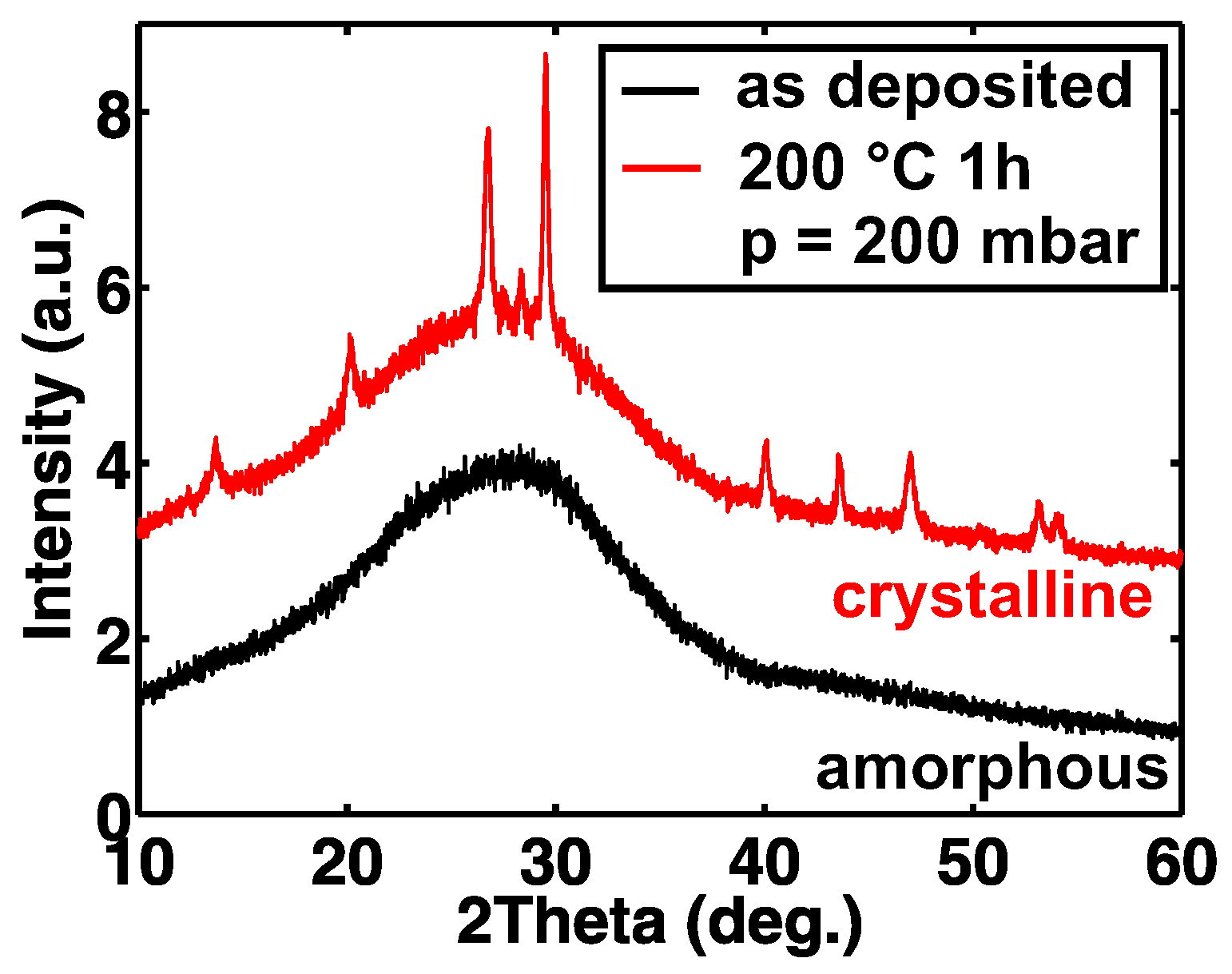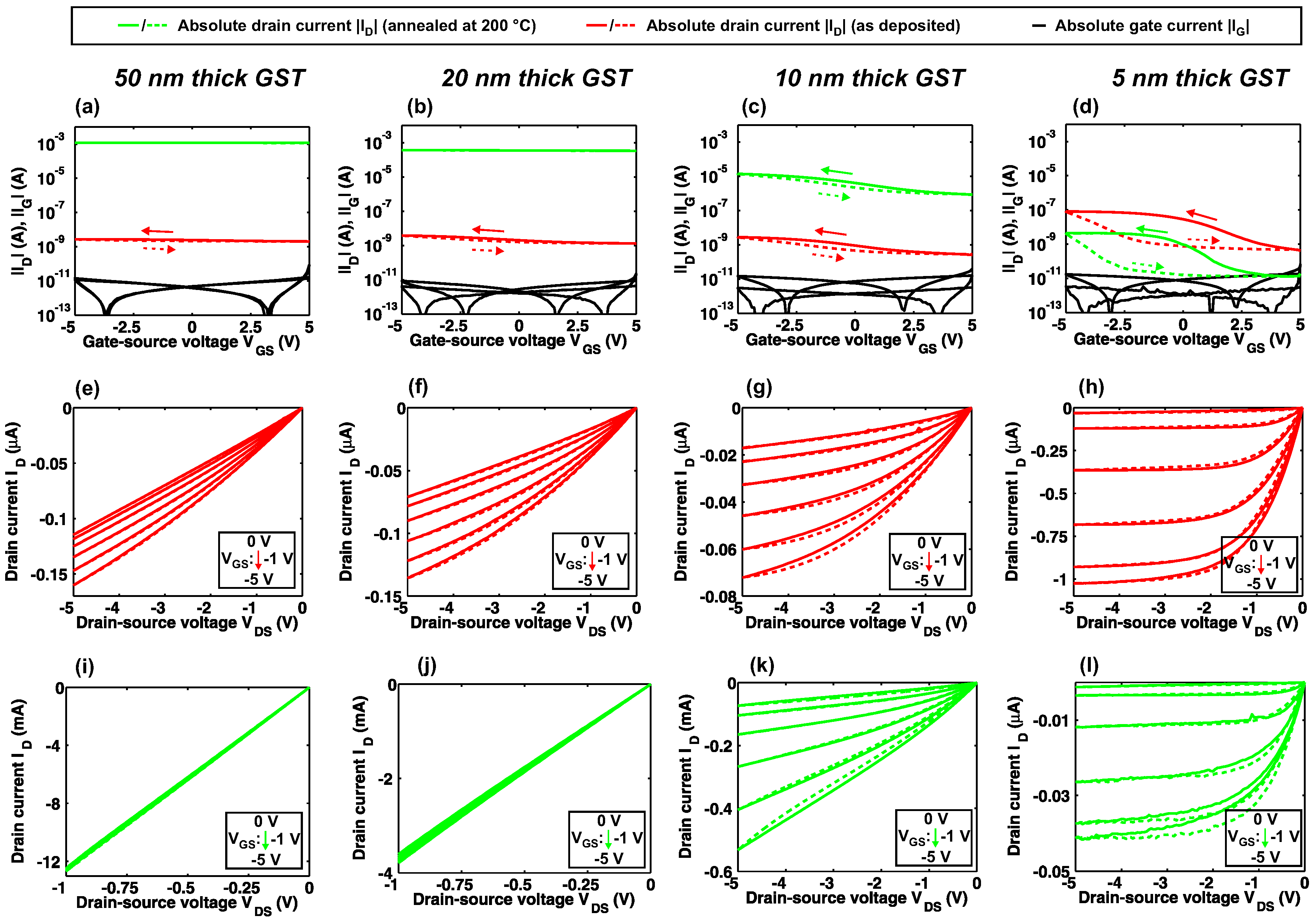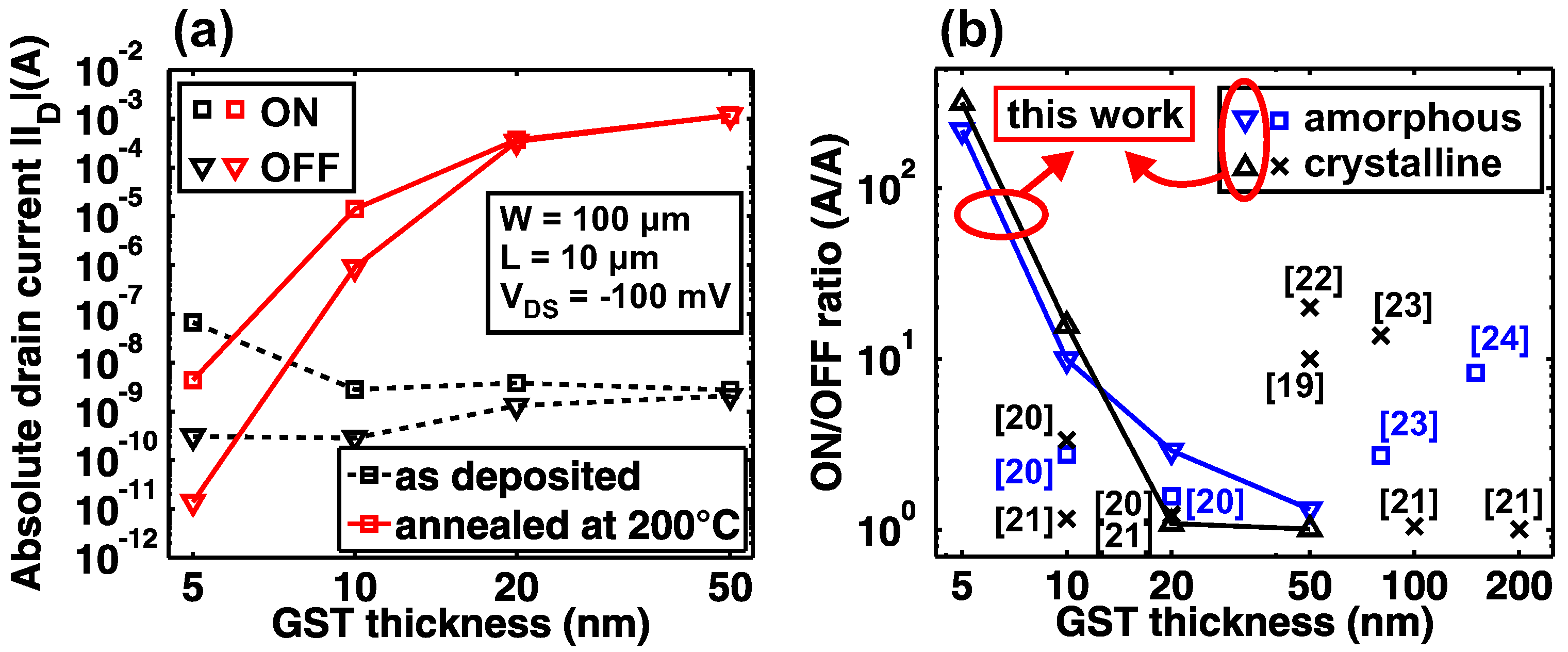Ge2Sb2Te5 p-Type Thin-Film Transistors on Flexible Plastic Foil
Abstract
1. Introduction
2. Experimental
2.1. Device Fabrication
2.2. Material Characterization
2.3. Thin-Film Transistor Characterization
3. Results and Discussion
4. Conclusions and Outlook
Author Contributions
Funding
Acknowledgments
Conflicts of Interest
References
- Niu, Y.F.; Liu, S.F.; Chiou, J.Y.; Huang, C.Y.; Chiu, Y.W.; Lai, M.H.; Liu, Y.W. Improving the flexibility of AMOLED display through modulating thickness of layer stack structure. J. Soc. Inf. Disp. 2016, 24, 293–298. [Google Scholar] [CrossRef]
- Takei, K. High performance, flexible CMOS circuits and sensors toward wearable healthcare applications. In Proceedings of the 2016 IEEE International Electron Devices Meeting (IEDM), San Francisco, CA, USA, 3–7 December 2016; pp. 6.1.1–6.1.4. [Google Scholar]
- Sekitani, T.; Someya, T. Human-friendly organic integrated circuits. Mater. Today 2011, 14, 398–407. [Google Scholar] [CrossRef]
- Kim, D.H.; Lu, N.; Ma, R.; Kim, Y.S.; Kim, R.H.; Wang, S.; Wu, J.; Won, S.M.; Tao, H.; Islam, A.; et al. Epidermal electronics. Science 2011, 333, 838–843. [Google Scholar] [CrossRef] [PubMed]
- Bauer, S. Flexible electronics: Sophisticated skin. Nat. Mater. 2013, 12, 871–872. [Google Scholar] [CrossRef] [PubMed]
- Cherenack, K.; Zysset, C.; Kinkeldei, T.; Münzenrieder, N.; Tröster, G. Woven electronic fibers with sensing and display functions for smart textiles. Adv. Mater. 2010, 22, 5178–5182. [Google Scholar] [CrossRef] [PubMed]
- Heremans, P.; Papadopoulos, N.; de Jamblinne de Meux, A.; Nag, M.; Steudel, S.; Rockele, M.; Gelinck, G.; Tripathi, A.; Genoe, J.; Myny, K. Flexible metal-oxide thin film transistor circuits for RFID and health patches. In Proceedings of the 2016 IEEE International Electron Devices Meeting (IEDM), San Francisco, CA, USA, 3–7 December 2016; pp. 6.3.1–6.3.4. [Google Scholar]
- Petti, L.; Münzenrieder, N.; Vogt, C.; Faber, H.; Büthe, L.; Cantarella, G.; Bottacchi, F.; Anthopoulos, T.D.; Tröster, G. Metal oxide semiconductor thin-film transistors for flexible electronics. Appl. Phys. Rev. 2016, 3, 021303. [Google Scholar] [CrossRef]
- Gupta, V.O. A survey on stunning IGZO technology. Int. J. Appl. Inf. Syst. 2013, 2249, 0868. [Google Scholar]
- Nathan, A.; Ahnood, A.; Cole, M.T.; Lee, S.; Suzuki, Y.; Hiralal, P.; Bonaccorso, F.; Hasan, T.; Garcia-Gancedo, L.; Dyadyusha, A.; et al. Flexible electronics: the next ubiquitous platform. Proc. IEEE 2012, 100, 1486–1517. [Google Scholar] [CrossRef]
- Münzenrieder, N.; Petti, L.; Zysset, C.; Kinkeldei, T.; Salvatore, G.A.; Tröster, G. Flexible self-aligned amorphous InGaZnO thin-film transistors with submicrometer channel length and a transit frequency of 135 MHz. IEEE Trans. Electron Devices 2013, 60, 2815–2820. [Google Scholar] [CrossRef]
- Yang, B.D.; Oh, J.M.; Kang, H.J.; Park, S.H.; Hwang, C.S.; Ryu, M.K.; Pi, J.E. A Transparent Logic Circuit for RFID Tag in a-IGZO TFT Technology. ETRI J. 2013, 35, 610–616. [Google Scholar] [CrossRef]
- Myny, K.; Tripathi, A.K.; van der Steen, J.L.; Cobb, B. Flexible thin-film NFC tags. IEEE Commun. Mag. 2015, 53, 182–189. [Google Scholar] [CrossRef]
- Li, Y.S.; He, J.C.; Hsu, S.M.; Lee, C.C.; Su, D.Y.; Tsai, F.Y.; Cheng, I.C. Flexible complementary oxide–semiconductor-based circuits employing n-channel ZnO and p-channel SnO thin-film transistors. IEEE Electron Devices Lett. 2016, 37, 46–49. [Google Scholar] [CrossRef]
- Honda, W.; Arie, T.; Akita, S.; Takei, K. Bendable CMOS Digital and Analog Circuits Monolithically Integrated with a Temperature Sensor. Adv. Mater. Technol. 2016, 1. [Google Scholar] [CrossRef]
- Petti, L.; Bottacchi, F.; Münzenrieder, N.; Faber, H.; Cantarella, G.; Vogt, C.; Büthe, L.; Namal, I.; Späth, F.; Hertel, T.; et al. Integration of solution-processed (7, 5) SWCNTs with sputtered and spray-coated metal oxides for flexible complementary inverters. In Proceedings of the 2014 IEEE International Electron Devices Meeting, San Francisco, CA, USA, 15–17 December 2014; pp. 26.4.1–26.4.4. [Google Scholar]
- Chen, H.; Cao, Y.; Zhang, J.; Zhou, C. Large-scale complementary macroelectronics using hybrid integration of carbon nanotubes and IGZO thin-film transistors. Nat. Commun. 2014, 5, 4097. [Google Scholar] [CrossRef] [PubMed]
- Petti, L.; Loghin, F.; Cantarella, G.; Vogt, C.; Münzenrieder, N.; Abdellah, A.; Becherer, M.; Haeberle, T.; Daus, A.; Salvatore, G.; et al. Gain-tunable complementary common-source amplifier based on a flexible hybrid thin-film transistor technology. IEEE Electron Device Lett. 2017, 38, 1536–1539. [Google Scholar] [CrossRef]
- Hosaka, S.; Miyauchi, K.; Tamura, T.; Sone, H.; Koyanagi, H. Proposal for a memory transistor using phase-change and nanosize effects. Microelectron. Eng. 2004, 73, 736–740. [Google Scholar] [CrossRef]
- Yin, Y.; Miyachi, A.; Niida, D.; Sone, H.; Hosaka, S. Electrical properties of phase change and channel current control in ultrathin phase-change channel transistor memory by annealing. Jpn. J. Appl. Phys. 2006, 45, 3238. [Google Scholar] [CrossRef]
- Yin, Y.; Miyachi, A.; Niida, D.; Sone, H.; Hosaka, S. Thickness Dependences of Phase Change and Channel Current Control in Phase-Change Channel Transistor. In Proceedings of the 2005 IEEE Conference on Electron Devices and Solid-State Circuits, Hong Kong, China, 19–21 December 2005; pp. 617–620. [Google Scholar]
- Hosaka, S.; Miyauchi, K.; Tamura, T.; Yin, Y.; Sone, H. Prototype of phase-change channel transistor for both nonvolatile memory and current control. IEEE Trans. Electron Devices 2007, 54, 517–523. [Google Scholar] [CrossRef]
- Liao, F.; Ding, Y.; Lin, Y.; Tang, T.; Qiao, B.; Lai, Y.; Feng, J.; Chen, B. Characterization of Ge2Sb2Te5 thin film transistor and its application in non-volatile memory. Microelectron. J. 2006, 37, 841–844. [Google Scholar] [CrossRef]
- Cai, Y.; Zhou, P.; Tang, T.; Gao, C.; Lin, Y. Multi-Bit Storage Based on Chalcogenide Thin Film Transistor for High Density Nonvolatile Memory Application. Integr. Ferroelectr. 2009, 110, 34–42. [Google Scholar] [CrossRef]
- Song, K.B.; Lee, S.S.; Kim, K.A.; Suh, J.D.; Kim, J.H.; Lee, T.S.; Cheong, B.K.; Kim, W.M. Undoped homojunction chalcogen thin-film transistors on glass. Appl. Phys. Lett. 2007, 90, 263510. [Google Scholar] [CrossRef]
- Song, K.B.; Sohn, S.W.; Kim, J.; Kim, K.A.; Cho, K. Chalcogenide thin-film transistors using oxygenated n-type and p-type phase change materials. Appl. Phys. Lett. 2008, 93, 043514. [Google Scholar] [CrossRef]
- Kato, T.; Tanaka, K. Electronic properties of amorphous and crystalline Ge2Sb2Te5 films. Jpn. J. Appl. Phys. 2005, 44, 7340. [Google Scholar] [CrossRef]
- Yanez-Limon, J.; González-Hernández, J.; Alvarado-Gil, J.; Delgadillo, I.; Vargas, H. Thermal and electrical properties of the Ge: Sb: Te system by photoacoustic and Hall measurements. Phys. Rev. B 1995, 52, 16321. [Google Scholar] [CrossRef]
- Wong, H.S.P.; Raoux, S.; Kim, S.; Liang, J.; Reifenberg, J.P.; Rajendran, B.; Asheghi, M.; Goodson, K.E. Phase change memory. Proc. IEEE 2010, 98, 2201–2227. [Google Scholar] [CrossRef]
- Kolobov, A.V.; Fons, P.; Frenkel, A.I.; Ankudinov, A.L.; Tominaga, J.; Uruga, T. Understanding the phase-change mechanism of rewritable optical media. Nat. Mater. 2004, 3, 703–708. [Google Scholar] [CrossRef] [PubMed]
- Schlich, F.F.; Wyss, A.; Galinski, H.; Spolenak, R. Cohesive and adhesive properties of ultrathin amorphous and crystalline Ge2Sb2Te5 films on polyimide substrates. Acta Mater. 2017, 126, 264–271. [Google Scholar] [CrossRef]
- Ting, Z.; Bo, L.; Ji-Lin, X.; Zhi-Tang, S.; Song-Lin, F.; Bomy, C. Structure and electrical properties of Ge2Sb2Te5 thin film used for ovonic unified memory. Chin. Phys. Lett. 2004, 21, 741. [Google Scholar] [CrossRef]
- Zhang, Z.; Pan, J.; Fang, L.W.W.; Yeo, Y.C.; Foo, Y.L.; Zhao, R.; Shi, L.; Tok, E.S. Temperature-dependent phase separation during annealing of Ge2Sb2Te5 thin films in vacuum. Appl. Surf. Sci. 2012, 258, 6075–6079. [Google Scholar] [CrossRef]
- Baily, S.; Emin, D.; Li, H. Hall mobility of amorphous Ge2Sb2Te5. Solid State Commun. 2006, 139, 161–164. [Google Scholar] [CrossRef]
- Lee, B.S.; Abelson, J.R.; Bishop, S.G.; Kang, D.H.; Cheong, B.K.; Kim, K.B. Investigation of the optical and electronic properties of Ge2Sb2Te5 phase change material in its amorphous, cubic, and hexagonal phases. J. Appl. Phys. 2005, 97, 093509. [Google Scholar] [CrossRef]
- Pirovano, A.; Lacaita, A.L.; Benvenuti, A.; Pellizzer, F.; Bez, R. Electronic switching in phase-change memories. IEEE Trans. Electron Devices 2004, 51, 452–459. [Google Scholar] [CrossRef]
- Pirovano, A.; Lacaita, A.L.; Pellizzer, F.; Kostylev, S.A.; Benvenuti, A.; Bez, R. Low-field amorphous state resistance and threshold voltage drift in chalcogenide materials. IEEE Trans. Electron Devices 2004, 51, 714–719. [Google Scholar] [CrossRef]
- Huang, B.; Robertson, J. Defect models and electrical storage mechanism in GeSbTe phase change materials. J. Non-Cryst. Solids 2012, 358, 2393–2397. [Google Scholar] [CrossRef]
- Jeong, J.; Hong, Y. Debye length and active layer thickness-dependent performance variations of amorphous oxide-based TFTs. IEEE Trans. Electron Devices 2012, 59, 710–714. [Google Scholar] [CrossRef]
- Martin, S.; Chiang, C.S.; Nahm, J.Y.; Li, T.; Kanicki, J.; Ugai, Y. Influence of the amorphous silicon thickness on top gate thin-film transistor electrical performances. Jpn. J. Appl. Phys. 2001, 40, 530. [Google Scholar] [CrossRef]
- Li, Y.; Pei, Y.; Hu, R.; Chen, Z.; Zhao, Y.; Shen, Z.; Fan, B.; Liang, J.; Wang, G. Effect of channel thickness on electrical performance of amorphous IGZO thin-film transistor with atomic layer deposited alumina oxide dielectric. Curr. Appl. Phys. 2014, 14, 941–945. [Google Scholar] [CrossRef]
- Lee, J.; Kim, K.; Kim, J.H.; Im, S.; Jung, D.Y. Optimum channel thickness in pentacene-based thin-film transistors. Appl. Phys. Lett. 2003, 82, 4169–4171. [Google Scholar] [CrossRef]
- Das, S.; Chen, H.Y.; Penumatcha, A.V.; Appenzeller, J. High performance multilayer MoS2 transistors with scandium contacts. Nano Lett. 2012, 13, 100–105. [Google Scholar] [CrossRef] [PubMed]
- Daus, A.; Han, S.; Knobelspies, S.; Cantarella, G.; Vogt, C.; Münzenrieder, N.; Tröster, G. Flexible CMOS electronics based on p-type Ge2Sb2Te5 and n-type InGaZnO4 semiconductors. In Proceedings of the 2017 IEEE International Electron Devices Meeting (IEDM), San Francisco, CA, USA, 2–6 December 2017; pp. 8.1.1–8.1.4. [Google Scholar]
- Daus, A.; Roldán-Carmona, C.; Domanski, K.; Knobelspies, S.; Cantarella, G.; Vogt, C.; Grätzel, M.; Nazeeruddin, M.K.; Tröster, G. Metal-Halide Perovskites for Gate Dielectrics in Field-Effect Transistors and Photodetectors Enabled by PMMA Lift-Off Process. Adv. Mater. 2018, 30, 1707412. [Google Scholar] [CrossRef] [PubMed]
- Zysset, C.; Münzenrieder, N.; Petti, L.; Büthe, L.; Salvatore, G.A.; Tröster, G. IGZO TFT-based all-enhancement operational amplifier bent to a radius of 5 mm. IEEE Electron Device Lett. 2013, 34, 1394–1396. [Google Scholar] [CrossRef]
- Münzenrieder, N.; Zysset, C.; Petti, L.; Kinkeldei, T.; Salvatore, G.A.; Tröster, G. Flexible double gate a-IGZO TFT fabricated on free standing polyimide foil. Solid State Electron. 2013, 84, 198–204. [Google Scholar] [CrossRef]
- Braga, S.; Cabrini, A.; Torelli, G. Dependence of resistance drift on the amorphous cap size in phase change memory arrays. Appl. Phys. Lett. 2009, 94, 092112. [Google Scholar] [CrossRef]
- Ielmini, D.; Lavizzari, S.; Sharma, D.; Lacaita, A.L. Physical interpretation, modeling and impact on phase change memory (PCM) reliability of resistance drift due to chalcogenide structural relaxation. In Proceedings of the 2007 IEEE International Electron Devices Meeting, Washington, DC, USA, 10–12 December 2007; pp. 939–942. [Google Scholar]
- Caravati, S.; Bernasconi, M.; Kühne, T.; Krack, M.; Parrinello, M. First-principles study of crystalline and amorphous Ge2Sb2Te5 and the effects of stoichiometric defects. J. Phys. Condens. Matter 2009, 21, 255501. [Google Scholar] [CrossRef] [PubMed]
- Choi, K.J.; Yoon, S.M.; Lee, N.Y.; Lee, S.Y.; Park, Y.S.; Yu, B.G.; Ryu, S.O. The effect of antimony-doping on Ge2Sb2Te5, a phase change material. Thin Solid Films 2008, 516, 8810–8812. [Google Scholar] [CrossRef]






| GST Thickness (nm) | V (V) as Deposited | V (V) Annealed at 200 °C | SS (V/Decade) as Deposited | SS (V/Decade) Annealed at 200 °C |
|---|---|---|---|---|
| 5 | 0.86 | 0.6 | 1.3 | 1.0 |
| 10 | 1.8 | 1.72 | 5.4 | 5.1 |
| 20 | 4.56 | - | 13 | - |
| 50 | 20.55 | - | 22 | - |
| GST Thickness (nm) | as Deposited | Annealed at 200 °C | Annealed at 200 °C | n Annealed at 200 °C |
|---|---|---|---|---|
| 5 | 0.041 | 0.0032 | - | - |
| 10 | 0.0014 | 6.72 | 2.79 | +9.6 |
| 20 | 0.0013 | - | 3.7 | +4.1 |
| 50 | 0.0004 | - | 2.92 | +7.2 |
© 2018 by the authors. Licensee MDPI, Basel, Switzerland. This article is an open access article distributed under the terms and conditions of the Creative Commons Attribution (CC BY) license (http://creativecommons.org/licenses/by/4.0/).
Share and Cite
Daus, A.; Han, S.; Knobelspies, S.; Cantarella, G.; Tröster, G. Ge2Sb2Te5 p-Type Thin-Film Transistors on Flexible Plastic Foil. Materials 2018, 11, 1672. https://doi.org/10.3390/ma11091672
Daus A, Han S, Knobelspies S, Cantarella G, Tröster G. Ge2Sb2Te5 p-Type Thin-Film Transistors on Flexible Plastic Foil. Materials. 2018; 11(9):1672. https://doi.org/10.3390/ma11091672
Chicago/Turabian StyleDaus, Alwin, Songyi Han, Stefan Knobelspies, Giuseppe Cantarella, and Gerhard Tröster. 2018. "Ge2Sb2Te5 p-Type Thin-Film Transistors on Flexible Plastic Foil" Materials 11, no. 9: 1672. https://doi.org/10.3390/ma11091672
APA StyleDaus, A., Han, S., Knobelspies, S., Cantarella, G., & Tröster, G. (2018). Ge2Sb2Te5 p-Type Thin-Film Transistors on Flexible Plastic Foil. Materials, 11(9), 1672. https://doi.org/10.3390/ma11091672




